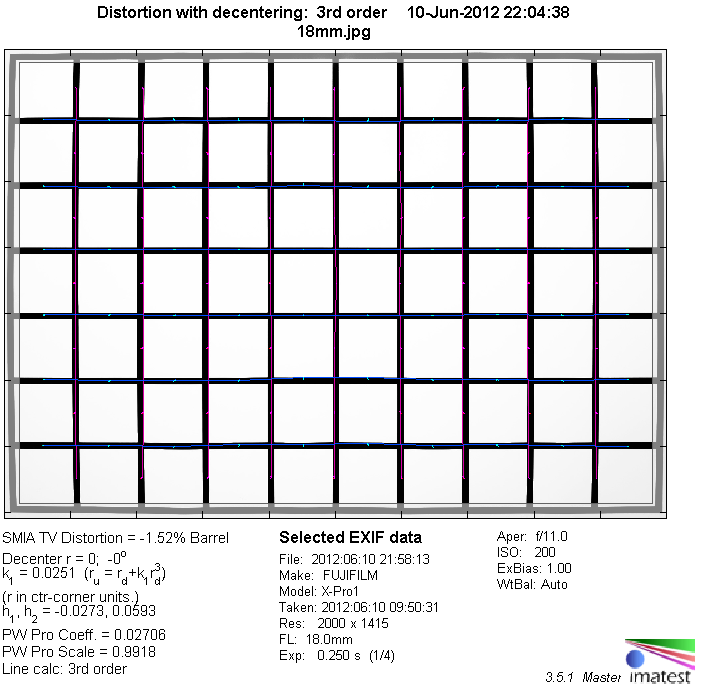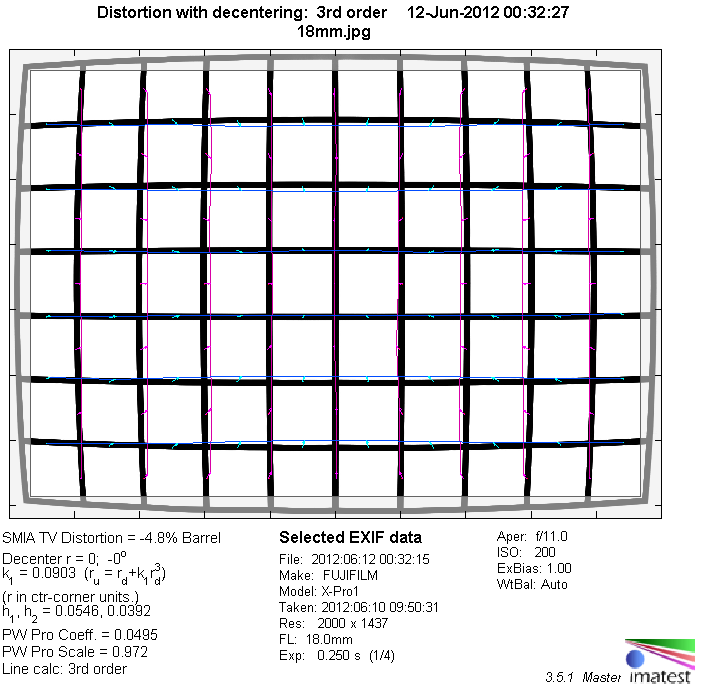|
Fujinon XF 18mm f/2 R (Fujifilm) - Review / Test Report - Analysis |
|
Lens Reviews -
Fujifilm X
|
|
Page 2 of 3

Distortion
The distortion characteristic is a two-sided thing. It may not be widely known but the X-Pro1 applies distortion auto-correction - same goes for the Fuji RAW converter. So if you follow the "native" approach, the Fujinon XF 18mm f/2 R produces only a moderate barrel distortion (~1.5%). However, the situation is very different when using a third-party RAW converter. We measured a RAW barrel distortion of 4.8% which is nothing short of extreme. This is a bit unfortunate given the comparatively high pricing of the lens but then Micro-Four-Thirds or Samsung NX follow a similar approach.
Auto-corrected distortion:
 RAW distortion:
RAW distortion:

Vignetting
The light falloff of the lens is quite well controlled. At max. aperture the vignetting is visible at ~0.8EV (f-stops) and, as usual, it helps to stop down to reduce the issue. However, even at f/8 you've to live with a moderate vignetting (~0.5EV) which isn't overly disturbing though.
Due to the image cropping during the distortion correction the vignetting (as seen in the figures) is a little lower than in "RAW" mode.

MTF (resolution)
The Fujinon has a quite decent resolution characteristic but it is not flawless here. The center quality is very good at f/2 and the borders are also fine but the corners are very soft at this setting. The corner quality increases to acceptable levels at f/2.8 but you really need to stop down to f/4-f/8 to reach good to very good results here. There's also a bit of field curvature so it is advisable to stop down to at least f/8 to compensate this. Diffraction has a higher impact from f/11 onward.
The centering quality of the tested sample was very good.
The chart has been updated compared to the initial version. We have moved to CaptureOne for RAW processing. However, the differences are rather marginal.
Please note that the MTF results are not directly comparable across the different systems!
Below is a simplified summary of the formal findings. The chart shows line widths
per picture height (LW/PH) which can be taken as a measure for sharpness.
If you want to know more about the MTF50 figures you may check out the corresponding
Imatest Explanations
Chromatic Aberrations (CAs)
Lateral CAs (color shadows at hard contrast transitions) are a weakness of the Fuji lens. The issue is comparatively moderate at max. aperture but at medium apertures the average CA pixel width approaches 1.8px at the image boders. This is visible and decreases the subjective quality perception.

|